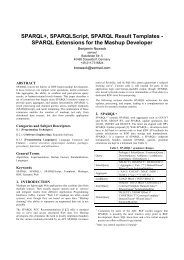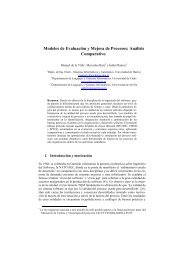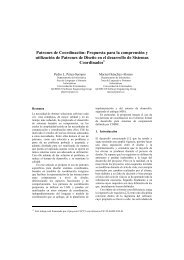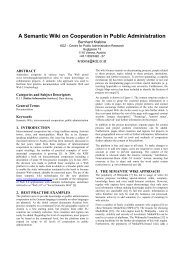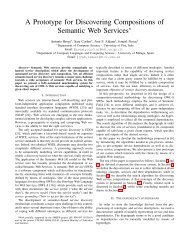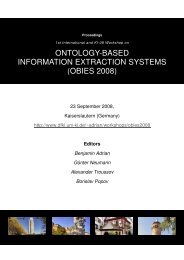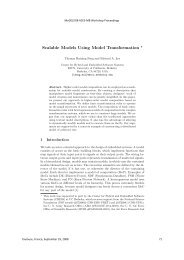Sim-Filter: User Profile based Smart Information Filtering and - FTP
Sim-Filter: User Profile based Smart Information Filtering and - FTP
Sim-Filter: User Profile based Smart Information Filtering and - FTP
Create successful ePaper yourself
Turn your PDF publications into a flip-book with our unique Google optimized e-Paper software.
ecall, that user profile is composed of user identity <strong>and</strong> preferences. Preferences are<br />
first stored in explicit manner, <strong>and</strong> then enriched implicitly. Our system observes the<br />
user's actions <strong>and</strong> deducts some of implicit data that represent his opinions on the<br />
proposed information.<br />
<strong>Smart</strong>card<br />
PicoDBMS<br />
JDBCDriver<br />
SQL<br />
Fig. 5. <strong>User</strong> profile implementation<br />
Java Interface<br />
For example, suppose that user likes classical music. He setup his preference<br />
according to this choice. For this, our application maintains a list of MIME file type<br />
that specifies the type of each file in the Internet. When user clicks on music file on<br />
the web, we can detect the kind of this music (technique known as “click-stream<br />
tracking”). By analyzing the behaviors of the user, <strong>based</strong> on the number of time that a<br />
given link has been selected of a list of results, the number of time that a document<br />
has been consulted, the time passed on a document or a site, etc., we detect that the<br />
user often listen to rock music. Therefore, our system adapts user preference <strong>and</strong><br />
update/add rock music to user preferences.<br />
4 Internet Based <strong>Filter</strong>ing System<br />
There are two techniques of information filtering. Fig. 6. explains these techniques. In<br />
the first case, the user formulates his request (Request Q1), which is combined with<br />
his profile before queering the web. In the second case, the result of the request<br />
(Request Q2) is combined with the profile to get only pertinent response. The<br />
advantage of the first technique is the optimization of the resources used such as<br />
b<strong>and</strong>width consumption <strong>and</strong> execution time. It presents some drawback related to the<br />
security <strong>and</strong> confidentiality of the profile. It is clear, that in this case everyone can<br />
discover user profile, which may contain personal <strong>and</strong> private information about the<br />
user. It is necessary then to secure the storage of the profile (this is already provided<br />
by the smartcard) but also its transfers (network communication). The second<br />
technique deals with the security problem, since the profile is combined locally with<br />
the request only after getting responses. The drawback of this technique is the<br />
resources consumption.



